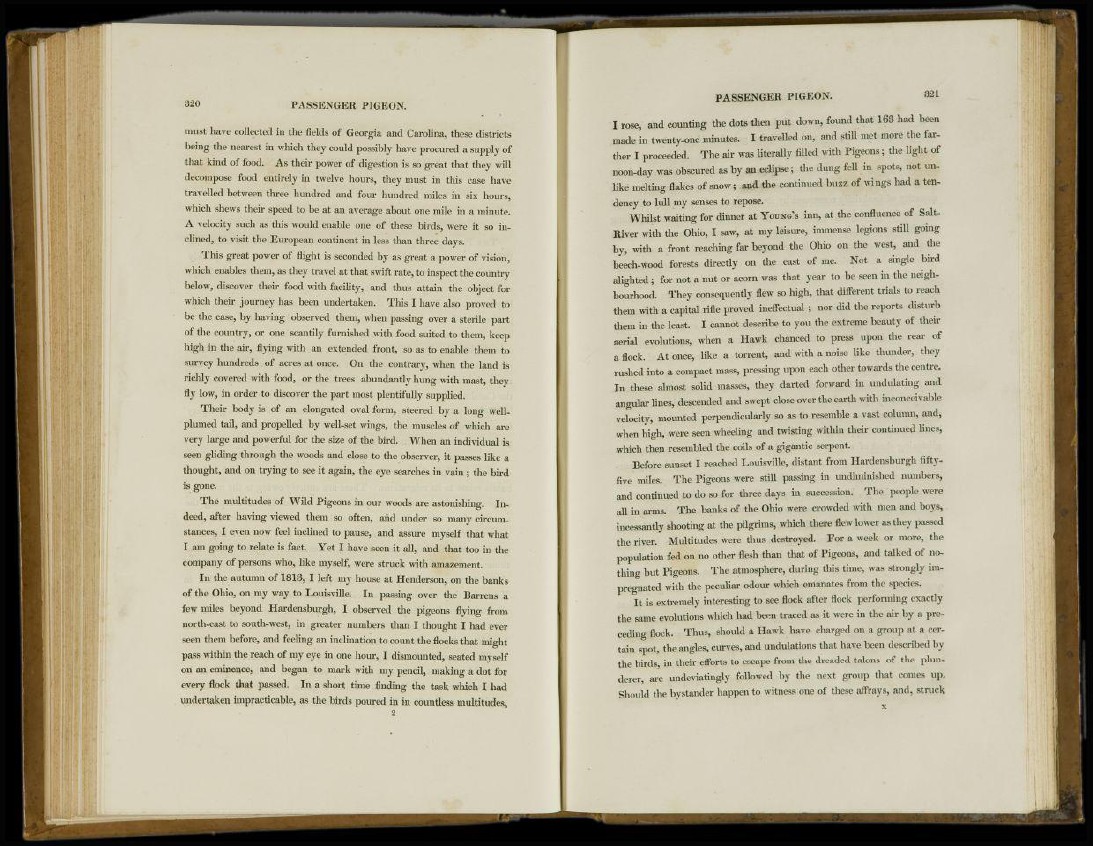
PASSENGER PIGEON. 321
I rose, and counting the dots then put down, found that 163 had been
made in twenty-one minutes. I travelled on, and still met more the farther
I proceeded. The air was literally filled with Pigeons; the light of
noon-day was obscured as by an eclipse; the dung fell in spots, not unlike
melting flakes of snow; and the continued buzz of wings had a tendency
to lull my senses to repose.
Whilst waiting for dinner at YOUNG'S inn, at the confluence of Salt-
River with the Ohio, I saw, at my leisure, immense legions still going
by, with a front reaching far beyond the Ohio on the west, and the
beech-wood forests directly on the east of me. Not a single bird
alighted; for not a nut or acorn was that year to be seen in the neighbourhood.
They consequently flew so high, that different trials to reach
them with a capital rifle proved ineffectual ; nor did the reports disturb
them in the least. I cannot describe to you the extreme beauty of their
aerial evolutions, when a Hawk chanced to press upon the rear of
a flock. At once, like a torrent, and with a noise like thunder, they
rushed into a compact mass, pressing upon each other towards the centre.
In these almost solid masses, they darted forward in undulating and
angular lines, descended and swept close over the earth with inconceivable
velocity, mounted perpendicularly so as to resemble a vast column, and,
when high, were seen wheeling and twisting within their continued lines,
which then resembled the coils of a gigantic serpent.
Before sunset I reached Louisville, distant from Hardensburgh fiftyfive
miles. The Pigeons were still passing in undiminished numbers,
and continued to do so for three days in succession. The people were
all in arms. The banks of the Ohio were crowded with men and boys,
incessantly shooting at the pilgrims, which there flew lower as they passed
the river. Multitudes were thus destroyed. For a week or more, the
population fed on no other flesh than that of Pigeons, and talked of nothing
but Pigeons. The atmosphere, during this time, was strongly impregnated
with the peculiar odour which emanates from the species.
It is extremely interesting to see flock after flock performing exactly
the same evolutions which had been traced as it were in the air by a preceding
flock. Thus, should a Hawk have charged on a group at a certain
spot, the angles, curves, and undulations that have been described by
the birds, in their efforts to escape from the dreaded talons of the plunderer,
are undeviatingly followed by the next group that comes up.
Should the bystander happen to witness one of these affrays, and, struck
x
must have collected in the fields of Georgia and Carolina, these districts
being the nearest in which they could possibly have procured a supply of
that kind of food. As their power of digestion is so great that they will
decompose food entirely in twelve hours, they must in this case have
travelled between three hundred and four hundred miles in six hours,
which shews their speed to be at an average about one mile in a minute.
A velocity such as this would enable one of these birds, were it so inclined,
to visit the European continent in less than three days.
This great power of flight is seconded by as great a power of vision,
which enables them, as they travel at that swift rate, to inspect the country
below, discover their food with facility, and thus attain the object for
which their journey has been undertaken. This I have also proved to
be the case, by having observed them, when passing over a sterile part
of the country, or one scantily furnished with food suited to them, keep
high in the air, flying with an extended front, so as to enable them to
survey hundreds of acres at once. On the contrary, when the land is
richly covered with food, or the trees abundantly hung with mast, they
fly low, in order to discover the part most plentifully supplied.
Their body is of an elongated oval form, steered by a long wellplumed
tail, and propelled by well-set wings, the muscles of which are
very large and powerful for the size of the bird. When an individual is
seen gliding through the woods and close to the observer, it passes like a
thought, and on trying to see it again, the eye searches in vain; the bird
is gone.
The multitudes of Wild Pigeons in our woods are astonishing. Indeed,
after having viewed them so often, and under so many circumstances,
I even now feel inclined to pause, and assure myself that what
I am going to relate is fact. Yet I have seen it all, and that too in the
company of persons who, like myself, were struck with amazement.
In the autumn of 1813, I left my house at Henderson, on the banks
of the Ohio, on my way to Louisville. In passing over the Barrens a
few miles beyond Hardensburgh, I observed the pigeons flying from
north-east to south-west, in greater numbers than I thought I had ever
seen them before, and feeling an inclination to count the flocks that might
pass within the reach of my eye in one hour, I dismounted, seated myself
on an eminence, and began to mark with my pencil, making a dot for
every flock that passed. In a short time finding the task which I had
undertaken impracticable, as the birds poured in in countless multitudes,
2